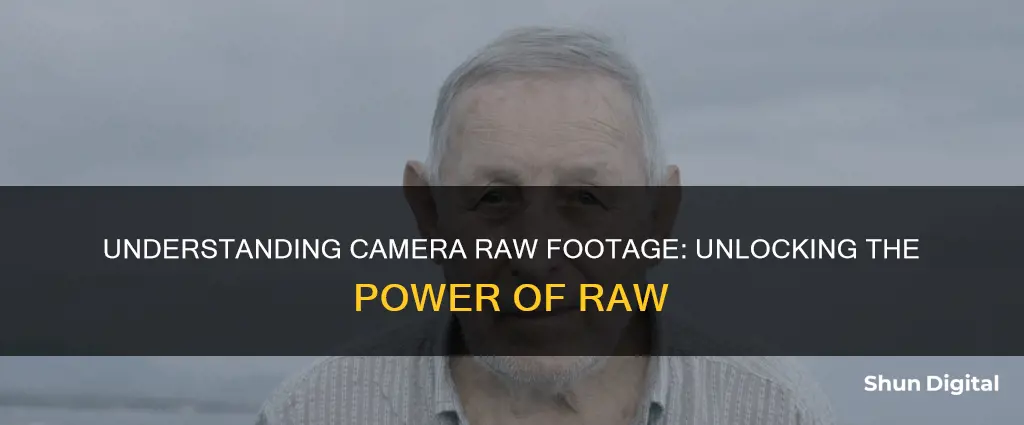
Raw camera footage is the crude, unprocessed output of a video or still camera recording. It is the unedited, raw data from a camera's image sensor. Raw footage is also known as source footage or source video. It is often disorganised and requires post-production to be viewed. It is intended to be edited and is not meant to be watched in its raw form.
| Characteristics | Values |
|---|---|
| Definition | Crude, unprocessed output of a video or still camera recording |
| Data | Plain, unprocessed data from a camera sensor |
| Editing | Requires post-production editing with software such as Blackmagic Resolve, RED Cine-X Pro, ARRIRAW, or Adobe Premiere Pro |
| Quality | Retains all details, true colors, and lighting, allowing for considerable modification |
| File Size | Large file sizes, requiring significant storage space |
| Cost | Expensive due to the cost of the camera and hardware for post-production |
| Flexibility | Provides flexibility in post-production, allowing for colour correction, exposure adjustments, and white balance changes |
| Use Cases | Suitable for professional-quality video production, but not for casual or home videos |
What You'll Learn
- Raw footage is the unprocessed data from a camera's image sensor
- It is the crude, unprocessed output of a video or camera recording
- Raw footage is also known as source footage or source video
- It is large in size and requires professional software to open
- Raw footage is meant to be edited and is not the final product

Raw footage is the unprocessed data from a camera's image sensor
Raw footage is the unedited, unprocessed data captured by a camera's image sensor. It is sometimes referred to as "source footage" and is the crude output of a video or still camera recording.
When shooting in a non-raw format, a camera will automatically process the footage and "bake" it into the finished video. However, raw footage is left unprocessed, allowing videographers and editors full creative control in post-production. This means they can manipulate the image data to achieve the desired look and feel without a loss in image quality. For example, they can alter the exposure, change the white balance, sharpen frames, and correct colours, shadows and highlights.
Raw footage is typically delivered as a long, disorganised list of files that may be out of order and will likely require professional software to open and edit. The files are large and take up a lot of storage space, and only a few cameras are capable of storing raw footage due to the high costs of the hardware and storage required.
Despite the challenges of working with raw footage, it is often preferred by photographers and videographers due to the high quality and flexibility it affords in post-production.
Cleaning Corroded Camera Battery Terminals: DIY Guide
You may want to see also

It is the crude, unprocessed output of a video or camera recording
Raw footage is the crude, unprocessed output of a video or camera recording. It is the raw data from a camera's image sensor, which has not been processed or edited in any way. This means that the footage retains all the details, true colours, and lighting as they were captured, allowing for considerable modification in post-production.
When shooting in a non-raw format, the camera automatically processes the footage and bakes it into the finished video. This can result in a loss of image quality and limit the options for editing. In contrast, raw footage offers professionals control over the images in the edit room, allowing them to manipulate the footage to achieve their desired look and feel.
However, working with raw footage can be challenging due to the large file sizes and the need for specialised software and hardware. Raw files are typically two to six times larger than standard compressed video files, requiring significant storage space and processing power. Additionally, only a few cameras can store raw footage, and the cost of the required hardware and software can be expensive.
Despite these challenges, raw footage is highly valued in professional video production as it provides the highest quality and flexibility in post-production. It allows editors to have the most creative freedom when putting together the final product. For this reason, raw footage is often used in serious, professional-quality productions where ultimate flexibility is required.
In summary, raw footage is the crude, unprocessed output of a video or camera recording. It offers numerous benefits in terms of image quality and editing capabilities, but it also comes with challenges related to file size and cost. As a result, it is typically used in professional settings where the benefits outweigh the drawbacks.
Understanding Camera Raw CS4: A Beginner's Guide
You may want to see also

Raw footage is also known as source footage or source video
Raw footage, sometimes called "source footage" or "source video", is the crude, unprocessed output data from a camera sensor that is captured while shooting. It is the raw, unrefined footage that retains all the details, true colours, and lighting as it was captured, allowing for considerable opportunity for modification.
Source footage is often delivered as a long, disorganised list of files that may not be able to be opened without professional software. This is by design, as raw footage is meant to be edited and transformed in post-production. Editors can colour-grade the footage, make technical changes, and synchronise audio to bring the footage to life and create a cohesive narrative.
The large file size of raw footage can be challenging, requiring significant storage space and processing power to work with. Additionally, not all cameras can store raw footage due to the lack of codecs that can handle this format. The high cost of cameras that can capture raw footage, as well as the hardware and storage needed to support its post-production, can be a significant expense.
Despite the challenges, raw footage is highly valued in professional video production as it provides ultimate flexibility and control in the editing process. Editors can manipulate the image data endlessly to achieve the desired look and feel for the final video product.
Simplisafe Cameras: Battery-Powered or Direct Plug-in?
You may want to see also

It is large in size and requires professional software to open
Raw camera footage is the crude, unprocessed output from a camera's image sensor. It is essentially the raw data captured by the camera before any image or video processing takes place. This means that the footage retains all the details, true colours, and lighting information captured by the camera, allowing for greater flexibility during post-production editing.
One of the key characteristics of raw camera footage is its large file size. Raw files are significantly larger than standard compressed video files, often ranging between twice and six times the size. This is because each uncompressed frame can be up to 5MB in size, resulting in substantial storage requirements. For example, a raw HD video at 30 frames per second would require 150MB of storage space per second. This large file size contributes to the high cost of shooting raw footage, as it demands extensive storage capacity and processing power.
The large file size of raw camera footage also necessitates the use of professional software for viewing and editing. Without specialised software, it can be challenging to open and work with raw files. Additionally, the extensive storage requirements of raw footage further emphasise the need for professional software solutions that can efficiently manage and process these large files.
The size and complexity of raw camera footage present significant advantages and disadvantages. On the one hand, the large file size ensures that all the data captured by the camera's sensor is preserved, providing editors with maximum control over the final product. This allows for extensive modifications, such as colour correction, audio enhancement, and frame-by-frame adjustments. However, the large file size also increases the cost and complexity of working with raw footage, making it less accessible for casual users or projects with limited resources.
In summary, raw camera footage is large in size due to the uncompressed nature of the data and the high volume of information captured by the camera's sensor. This requires substantial storage capacity and processing power, as well as professional software capable of handling the intensive computational demands of editing raw footage. While the large file size presents challenges, it also enables editors to have greater creative freedom and flexibility in the post-production process.
Low Battery, Low Quality: Camera Performance Impact
You may want to see also

Raw footage is meant to be edited and is not the final product
Raw footage is the crude, unprocessed output of a camera's image sensor. It is often referred to as "source footage" as it is the first capture of the cinematographer during a shoot. This footage is meant to be edited and is not meant to be the final product. It is often disorganised, with files that may be out of order and difficult to open without the right software. The colours may look dull or flat, and the audio rough. This is because raw footage is meant to preserve the quality and detail for editors to have creative freedom when putting together the final product. Editors can colour grade the footage, synchronise audio, and make other technical changes to bring the colours to life.
Raw footage is meant to be edited because it gives editors the flexibility to shape the look and feel of the video. Editors can tweak the image data, alter exposure, change white balance, sharpen frames, and correct colours, shadows and highlights. This allows them to fix any errors made during shooting and balance colour temperatures when moving between different lighting situations.
Additionally, raw footage includes all videos, even those that will not make it into the final cut. Editors will weave together the perfect narrative from the shots available, leaving out any shots that do not add value to the story. They will also filter out any bloopers or mishaps during the shoot. The audio for the final video may also be recorded separately and synchronised with the footage during post-production.
The large file size of raw footage can be a challenge, requiring substantial storage space and a computer with powerful processing capabilities. However, the benefits of raw footage include the high-quality results and creative flexibility it provides. Editors can resize, cut, edit, and add effects while still maintaining the quality of the footage.
Unleash Special Effects: Camera Raw Power
You may want to see also
Frequently asked questions
Raw footage is the crude, unprocessed output of a camera sensor. It is the raw, unedited material as originally filmed by a movie camera or recorded by a video camera.
Raw footage is useful because it preserves the quality and detail of the true colours, lighting, and high-quality images that the camera produces. This allows editors to have the most creative freedom when putting together the final video.
Raw footage will not look like the final video. It will be a long, disorganised list of files that may be out of order and will not have been colour-corrected, audio-enhanced, or trimmed.







